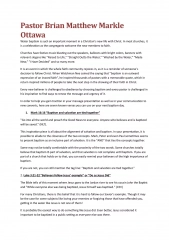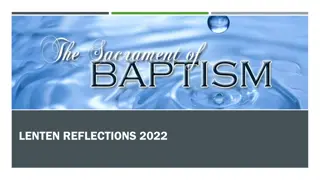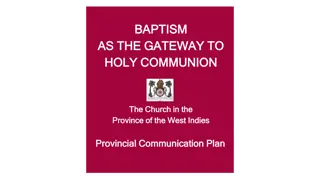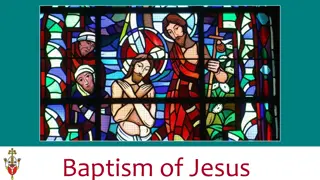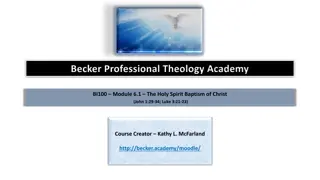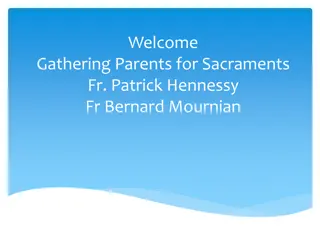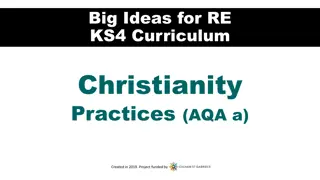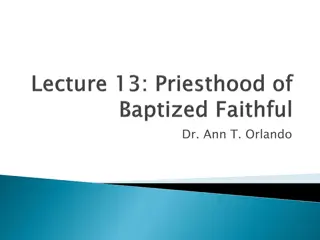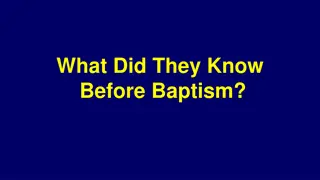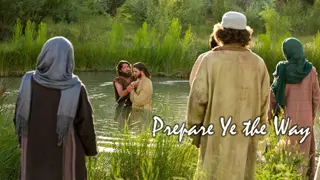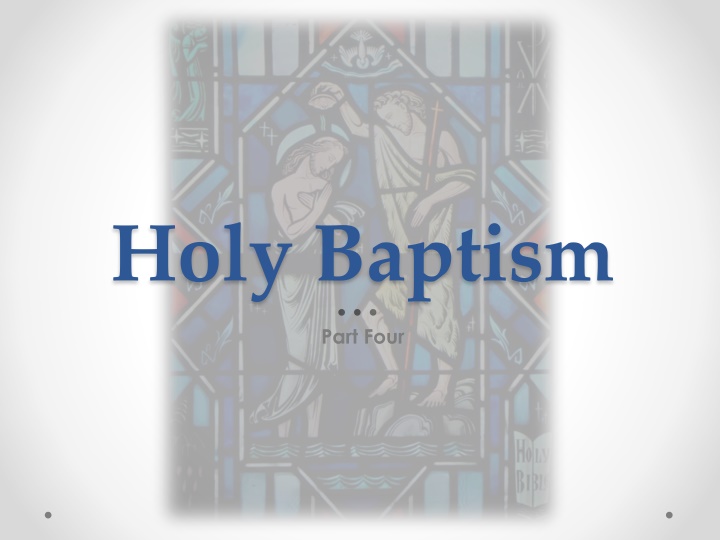
Meaning of Baptism in Mark 10:13-16 Explained
Discover the significance of baptism as shown in Mark 10:13-16. Learn how Jesus valued children and taught about salvation by grace through faith. Explore the biblical account of parents bringing their children to Jesus and the disciples' response.
Download Presentation

Please find below an Image/Link to download the presentation.
The content on the website is provided AS IS for your information and personal use only. It may not be sold, licensed, or shared on other websites without obtaining consent from the author. If you encounter any issues during the download, it is possible that the publisher has removed the file from their server.
You are allowed to download the files provided on this website for personal or commercial use, subject to the condition that they are used lawfully. All files are the property of their respective owners.
The content on the website is provided AS IS for your information and personal use only. It may not be sold, licensed, or shared on other websites without obtaining consent from the author.
E N D
Presentation Transcript
Holy Baptism Part Four
Review - Assignment -
Introduction Up to this point with Baptism we ve discussed: - What is it - Commanded by God - The benefits it gives - Forgiveness of sins - Rescues from death and the devil - Gives eternal salvation - How it can do such great things - Not just water - But God s word and the water - The faith that trusts this promise Now we get to What does such baptizing with water indicate?
Mark 10:13-16 Read Mark 10:13-16 Q: Who brought young children to Jesus? A: Parents Q: Why did they bring their children to Jesus? A: So He might touch them and give them the blessing of life and salvation that He had given to so many. They wanted their children to receive this life which Jesus came to give. St. Luke s account of this incident refers to the young children as infants (Luke 18:15).
Mark 10:13-16 Q: How did the disciples respond to those who brought their children to Jesus? A: They rebuked them. It was the custom of the Jewish rabbis to teach primarily the men of the congregation and those boys who had come of age. The women and their children did not approach the rabbis or stand with their men during instruction from the Scriptures. The action of the disciples reflected the belief of their day that children were a distraction since they couldn t understand and had nothing to offer.
Mark 10:13-16 Q: What did Jesus say in response to the disciples rebuke? A: Jesus rebuffed His disciples. Their actions was a denial of salvation by grace alone and not by works. Q: What does Jesus mean by the words, of such is the kingdom of God ? A: He is indicating that children too are the recipients of salvation by grace, through the divine action of the Lord alone.
Mark 10:13-16 Q: What does Jesus mean by the words, Assuredly, I say to you, whoever does not receive the kingdom of God as a little child will by no means enter it? A: He s not saying that the children have a unique ability or virtue in themselves which makes it possible for them to come to faith. Rather, becoming a Christian is exactly like being born in this world. You can t take credit for the life you received from God through your parents when you were born. So also you can t take credit for the new life of faith you receive from God through the Word when you re baptized.
Mark 10:13-16 Q: What did the children do in the story? A: Nothing! They were brought to Jesus. He picked them up and blessed them. They were the passive recipients of His grace and the gift of faith.
Mark 10:13-16 Q: Why is this passage used in the Church s liturgy for Holy Baptism? A: Holy Baptism is God s work. It s His gracious action through which He washes away sin for Jesus sake, bestows His Holy Spirit and faith, and makes us the very children of God. Our baptism is not a symbol for a decision we made to follow Jesus, nor does it represent any virtue in us or anything that we have done. As God s work, Holy Baptism joins us to Christ, so that every blessing of His incarnation, death, resurrection, and ascension might become our own. Holy Baptism makes us joint heirs with Him of eternal life with God the Father.
Small Catechism What does such baptizing with water indicate? It indicates that the Old Adam in us should by daily contrition and repentance be drowned and dies with all sins and evil desires, and that a new man should daily emerge and rise to live before God in righteousness and purity forever. Where is this written? St. Paul writes in Romans chapter six: We were therefore buried with Him through baptism into death in order that, just as Christ was raised from the dead through the glory of the Father, we too may live a new life (Rom. 6:4).
Small Catechism What does such baptizing with water indicate? It indicates that the Old Adam in us should by daily contrition and repentance be drowned and dies with all sins and evil desires This first part of Luther s explanation focuses on the Old Adam, and how he is daily drowned, crucified with Christ.
Small Catechism Q: Describe for me the old Adam A: It refers to: - Us as fallen creatures - Our complete and total corruption inherited from Adam. - Our unbelief and rebellion against the Creator. Ephesians 4:22, Put off your old self, which belongs to your former manner of life and is corrupt through deceitful desires.
Small Catechism What does such baptizing with water indicate? and that a new man should daily emerge and rise to live before God in righteousness and purity forever. This second part of Luther s explanation focuses on the New Man, and how he is daily brought to new life, raised with Christ.
Small Catechism Q: Describe for me the new man A: It refers to: - Us as restored creatures of God through the blood of Christ. - We have been united with Christ by the washing of rebirth. - We are made new through the work of the Holy Spirit in our lives. - We have new attitudes, desires, and behaviors 2 Corinthians 5:17, Therefore, if anyone is in Christ, he is a new creation. The old has passed away; behold, the new has comes.
Small Catechism Q: Describe for for me how the old Adam and the new man interact? A: They are engaged in an ongoing life and death struggle with each other. Galatians 5:17, For the desires of the flesh are against the Spirit, and the desires of the Spirit are against the flesh, for these are opposed to each other, to keep you from doing what you want to do.
Small Catechism Because of this struggle, we must live a baptismal life, that is: - Living in the promises that God made to you in your baptism. - By daily contrition and repentance. - Hearing the Word of God. - Confessing your sins. - Clinging to Christ for forgiveness in His Gospel and sacrament. - Living in selfless love toward the neighbor.
Large Catechism We see what a great and excellent thing baptism is, which snatches us from the jaws of the devil and makes us God s own, overcomes and takes away sin and daily strengthens the new person, and always endures and remains until we pass out of this misery into eternal glory (LC IV 83). Therefore let all Christians regard their baptism as the daily garment that they are to wear all the time. Every day they should be found in faith and with its fruits, suppressing the old creature and growing up in the new (LC IV 84-85).
Baptism in the Liturgy We remember our Baptism with the words in the name of the Father and of the Son and of the Holy Spirit (Matt. 28:19). In the Lutheran Service Book, each setting of the Divine Service has this note at the beginning of the liturgy: The sign of the cross + may be made by all in remembrance of their Baptism (LSB p. 151). Activity Using a hymnal, list the places in the Divine Service, marked with the small cross, where you are encouraged to make the sign of the cross.

